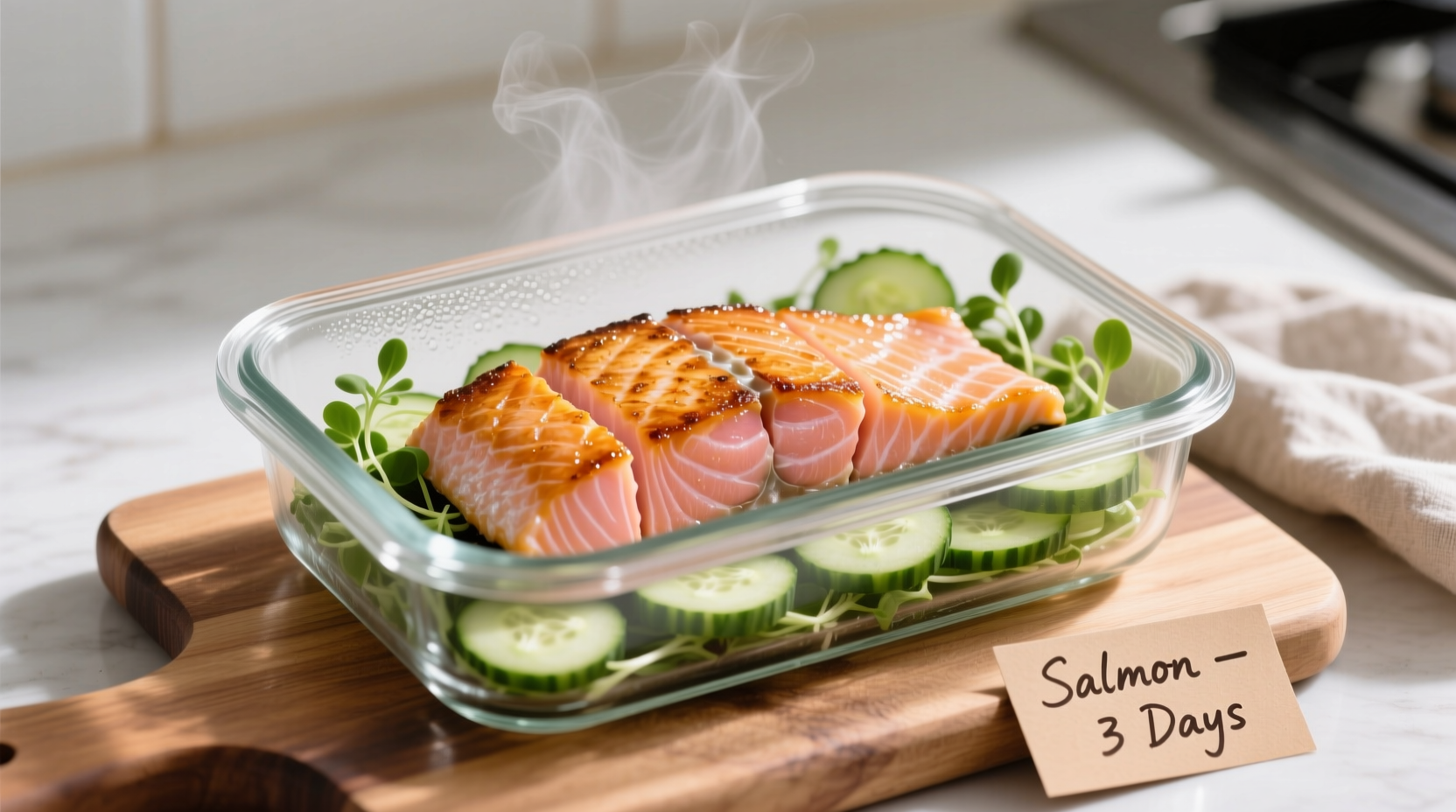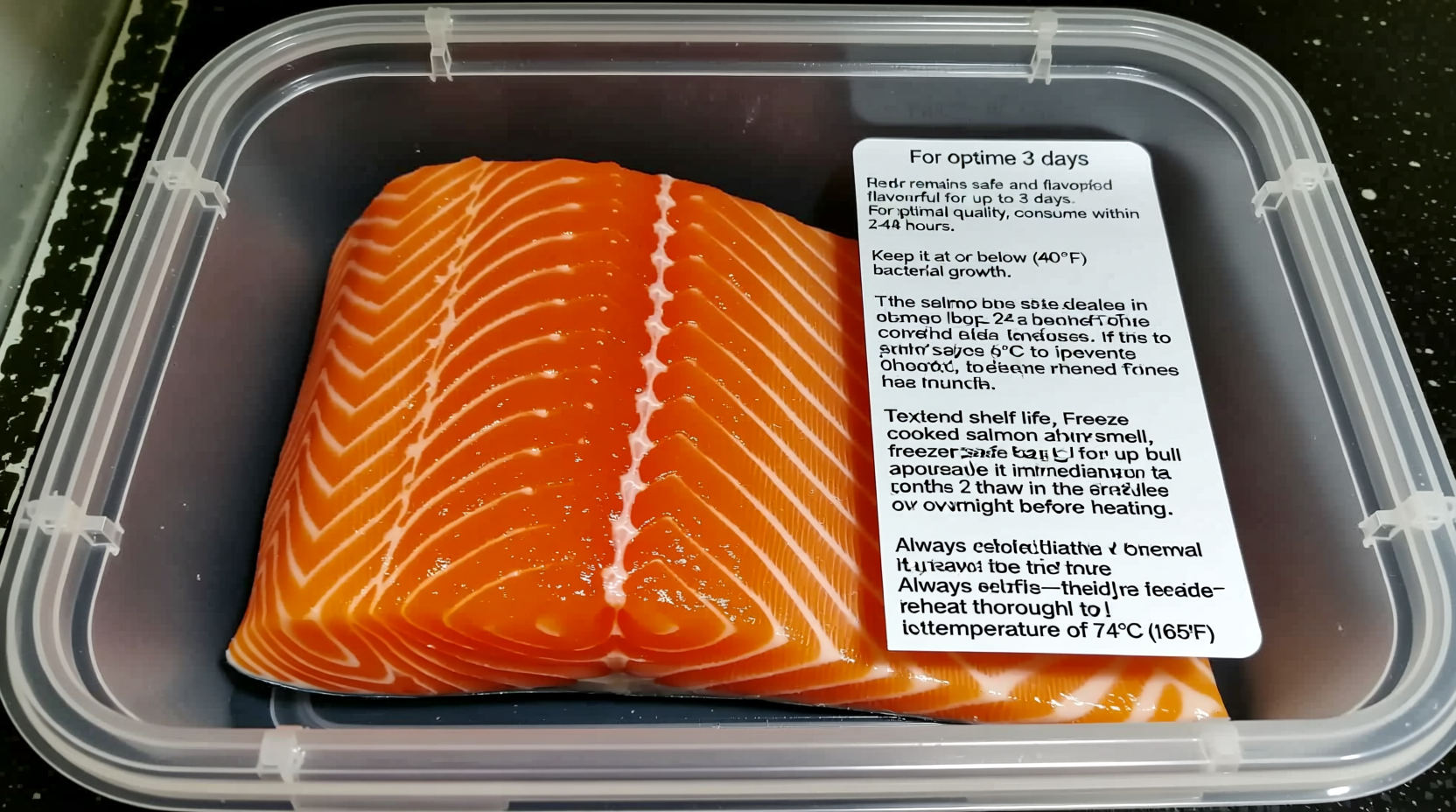Understanding proper food storage isn't just about avoiding waste—it's crucial for preventing foodborne illness. Salmon, like other fish, contains high levels of protein and moisture that create ideal conditions for bacterial growth when not stored correctly. The USDA Food Safety and Inspection Service confirms that cooked fish should be consumed within 3 to 4 days under proper refrigeration conditions.
Why the 3-4 Day Rule Matters for Cooked Salmon
Salmon's rich omega-3 fatty acid content makes it particularly susceptible to spoilage. When cooked salmon exceeds the recommended storage window, bacteria like Listeria monocytogenes and Vibrio can multiply rapidly, even in refrigerated conditions. According to the USDA Food Safety and Inspection Service, these pathogens cause thousands of foodborne illnesses annually.
Temperature control is your most effective defense. The "danger zone" for food safety spans 40°F to 140°F (4°C to 60°C), where bacteria double in number every 20 minutes. Your refrigerator must maintain a consistent 40°F or below to slow this process.
Optimal Storage Techniques for Maximum Freshness
How you store cooked salmon significantly impacts its shelf life. Follow these professional kitchen-tested methods:
- Immediate cooling: Transfer salmon to the refrigerator within 2 hours of cooking (1 hour if room temperature exceeds 90°F)
- Air-tight containment: Use glass containers with locking lids or vacuum-sealed bags to prevent moisture loss
- Strategic placement: Store on middle refrigerator shelves, not in the door where temperature fluctuates
- Moisture control: Place a paper towel beneath the salmon to absorb excess moisture
| Storage Method | Refrigerator Shelf Life | Freezer Shelf Life |
|---|---|---|
| Plastic container with lid | 3 days | 2 months |
| Aluminum foil wrap | 2 days | 1 month |
| Vacuum-sealed | 4 days | 6 months |
| Original packaging | 1-2 days | Not recommended |

Recognizing Spoiled Cooked Salmon: 4 Critical Signs
Don't rely solely on the calendar—your senses provide the most reliable spoilage indicators. Discard salmon showing any of these warning signs:
- Texture changes: Slimy film or excessive moisture on surface
- Odor shift: Sour, ammonia-like, or overly fishy smell (fresh cooked salmon has mild ocean scent)
- Color alteration: Dull appearance or grayish tinge instead of vibrant pink-orange
- Mold presence: Any visible fuzzy spots, regardless of color
The Centers for Disease Control and Prevention emphasizes that "when in doubt, throw it out" remains the golden rule for food safety. Pathogens that cause foodborne illness often don't produce noticeable changes in food appearance or smell.
Extending Your Cooked Salmon's Lifespan
When you need to preserve cooked salmon beyond 4 days, freezing provides a safe solution. Follow these steps for optimal results:
- Portion salmon into single-serving sizes before freezing
- Wrap tightly in freezer paper, then place in airtight container
- Label with date and contents using waterproof marker
- Freeze at 0°F (-18°C) or below for up to 6 months
Thaw frozen salmon safely by transferring to the refrigerator 24 hours before use. Never thaw at room temperature, as this creates ideal conditions for bacterial growth in the outer layers while the center remains frozen.
Common Storage Mistakes That Shorten Shelf Life
Even with proper refrigeration, these frequent errors compromise salmon's freshness:
- Leaving salmon on the counter during meal prep
- Storing in non-airtight containers that allow odor transfer
- Placing near refrigerator door where temperatures fluctuate
- Reheating multiple times, which accelerates spoilage
Professional kitchens follow the "first in, first out" (FIFO) principle for all prepared foods. When storing multiple batches, place newer containers behind older ones to ensure timely consumption.
Special Considerations for Different Salmon Types
While the 3-4 day rule applies generally, specific salmon preparations have unique considerations:
- Smoked salmon: Lasts 1-2 weeks unopened, but only 5-7 days after opening
- Salmon with sauces: Reduced shelf life to 2-3 days due to additional moisture
- Canned salmon: Remains safe for 3-4 days after opening when refrigerated
- Cold-smoked varieties: Higher risk profile requiring strict adherence to time limits
For those with compromised immune systems, the FDA recommends consuming cooked seafood within 2 days to minimize foodborne illness risks.
Practical Food Safety Timeline
Understanding the progression of bacterial growth helps visualize why timing matters:
- 0-2 hours post-cooking: Safe at room temperature (the "danger zone" begins after 2 hours)
- 2-4 hours: Bacteria begin multiplying rapidly; refrigerate immediately
- Day 1-2: Peak freshness and flavor; minimal bacterial growth
- Day 3: Approaching maximum safe storage; check for spoilage signs
- Day 4: Final safe consumption day; discard if any doubt exists
- Day 5+: High risk of foodborne illness; never consume
This timeline reflects data from the FDA Food Code 2022, which establishes standardized food safety practices for commercial kitchens across the United States.
When Leftover Salmon Makes Sense
Not all cooked salmon should follow the standard timeline. Consider these exceptions:
- Salmon cooked to 145°F (63°C) internal temperature maintains quality longer than medium-rare preparations
- Freshly caught wild salmon often has slightly longer shelf life than farmed varieties
- Salmon stored immediately after cooking lasts longer than salmon left at room temperature
Always prioritize safety over potential waste. The minimal cost of replacing spoiled salmon pales in comparison to medical expenses from foodborne illness.
Frequently Asked Questions
Can I eat cooked salmon after 5 days in the refrigerator?
No, cooked salmon should not be consumed after 5 days in the refrigerator. The USDA Food Safety and Inspection Service recommends discarding cooked fish after 3-4 days to prevent foodborne illness, even if it shows no visible signs of spoilage.
Does reheating cooked salmon extend its shelf life?
No, reheating does not reset the shelf life clock. Each reheating cycle accelerates spoilage by introducing moisture and creating temperature fluctuations. Reheat only the portion you plan to eat immediately, and consume within 2 hours of reheating.
How can I tell if cooked salmon has gone bad if it has no smell?
Lack of odor doesn't guarantee safety. Check for visual signs like slimy texture, color changes from pink to gray, or dry, flaky appearance. When in doubt, discard the salmon. Harmful bacteria like Listeria often don't produce noticeable odors in early spoilage stages.
Is it safe to freeze cooked salmon after 3 days in the fridge?
Yes, you can safely freeze cooked salmon that has been refrigerated for up to 3 days. Freezing stops bacterial growth, but doesn't reverse any spoilage that may have already occurred. For best quality, consume frozen salmon within 3 months, though it remains safe indefinitely at 0°F.
Does the cooking method affect how long salmon stays fresh?
Yes, cooking method impacts shelf life. Grilled or baked salmon typically lasts the full 3-4 days, while poached salmon (with higher moisture content) may only last 2-3 days. Smoked salmon has different storage requirements and can last longer when properly packaged.











 浙公网安备
33010002000092号
浙公网安备
33010002000092号 浙B2-20120091-4
浙B2-20120091-4